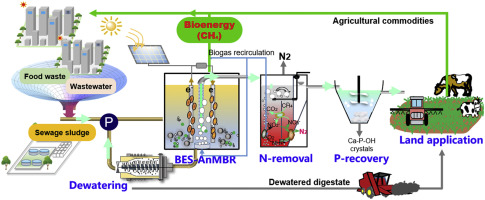Renewable and Sustainable Energy Reviews ( IF 16.3 ) Pub Date : 2019-09-18 , DOI: 10.1016/j.rser.2019.109392 Guangyin Zhen , Yang Pan , Xueqin Lu , Yu-You Li , Zhongyi Zhang , Chengxin Niu , Gopalakrishnan Kumar , Takuro Kobayashi , Youcai Zhao , Kaiqin Xu

|
Anaerobic membrane bioreactor (AnMBR) holds great promise to treat a broad range of waste streams for concurrent pollutants transformation and biofuels harvest while producing less digestate residuals. In this review, recent research advances, new discoveries and commercial application status of AnMBR technique were summarized and reported. A comprehensive comparison analysis designed herein demonstrated its fascinating superiorities over the conventional activated sludge-based processes with regards to good permeate quality, less digestate residuals, low operational costs, net profit/energy output, and outstanding economic and environmental benefits. Despite the great progress achieved previously, there are still numerous challenges head for AnMBR platform applications to be tackled, particularly for severe membrane fouling, low methane content in biogas, highly dissolved methane, poor ammonia removal and phosphorus recovery, etc. To address the above problems, a new-generation process, i.e. so-called “Integrated Multistage Bio-Process (IMBP)” constituted of solar-driven bioelectrochemical system (BES)-AnMBR, partial nitritation/anammox (PN/A), nitrate reduction via anaerobic oxidation of methane (AOM) and biological/chemical phosphorus precipitation units, was proposed in this article, with versatile capabilities in simultaneous biowastes valorization, CO2 electromethanogenesis and simultaneous biogas upgrading, in-situ fouling control, ammonia removal, dissolved methane reutilization, and phosphorus recover as hydroxyapatite-rich nutrients. Despite the uncertainties about whether this approach possesses the powerful potential to dominate the future, but most surely, this hybrid concept will enhance the deployment and industrial competitiveness of AnMBR-based technologies in real-world scenarios, facilitating the establishment of the energy-sustainable and low-carbon society. Of course, more efforts are still required to demonstrate the feasibility of this integrated biorefinery approach. Nonetheless, this review opens up new research opportunities to integrate with other newly emerging processes to develop robust, multifunctional and sustainable AnMBR-based technologies towards biowaste biorefinery, chemical energy harvest and green, carbon-neutral society.
中文翻译:

厌氧膜生物反应器用于生物废料生物精炼和化学能收集:最新进展,膜污染和未来前景
厌氧膜生物反应器(AnMBR)具有广阔的前景,可以处理各种废物流,以同时进行污染物转化和生物燃料收集,同时减少消化残余物。本文综述和报道了AnMBR技术的最新研究进展,新发现和商业应用现状。本文设计的综合比较分析表明,与传统的基于活性污泥的工艺相比,其渗透性好,渗透物质量好,消化残渣少,运行成本低,净利润/能源输出,经济和环境效益显着。尽管以前取得了长足的进步,但仍然需要解决AnMBR平台应用的众多挑战,尤其是对于严重的膜污染,2电甲烷形成和沼气同步升级,就地控制结垢,去除氨气,溶解的甲烷再利用和磷作为富含羟基磷灰石的养分而回收。尽管尚不确定这种方法是否具有统治未来的强大潜力,但最确定的是,这种混合概念将增强基于AnMBR的技术在实际场景中的部署和工业竞争力,从而促进建立能源可持续性和可持续性。低碳社会。当然,仍然需要更多的努力来证明这种整合的生物精炼方法的可行性。尽管如此,本综述为与其他新兴过程相结合开辟了新的研究机会,以开发基于健壮,多功能和可持续的基于AnMBR的技术,用于生物垃圾生物炼制,化学能收集和绿色碳中和社会。





















































 京公网安备 11010802027423号
京公网安备 11010802027423号